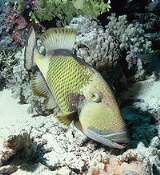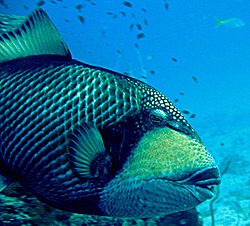
Titan triggerfish
Encyclopedia
The titan triggerfish, giant triggerfish or moustache triggerfish (Balistoides viridescens) is a large species of triggerfish
found in lagoon
s and at reefs in most of the Indo-Pacific
, though it is absent from Hawaii
. With a length of up to 75 centimetres (29.5 in), it is the largest species of triggerfish in its range (the stone triggerfish
, Pseudobalistes naufragium, from the east Pacific is larger).
, urchins
, crustacean
s and coral
. They are the workers of the reef, often being busy turning over rocks, stirring up the sand and biting off pieces of branching coral. This is why one often sees other smaller fish species around it who feed from the left overs.

The threat posture includes the triggerfish facing the intruder while holding its first dorsal spine errect. It may also roll onto its side, allowing it a better look at the intruder it perceives as threatening its nest. The titan triggerfish will not always bite, but can swim at snorkellers and divers escorting them out of their territory.
The flesh of the titan triggerfish is sometimes ciguatoxic
.
Triggerfish
Triggerfishes are about 40 species of often brightly colored fishes of the family Balistidae. Often marked by lines and spots, they inhabit tropical and subtropical oceans throughout the world, with the greatest species richness in the Indo-Pacific...
found in lagoon
Lagoon
A lagoon is a body of shallow sea water or brackish water separated from the sea by some form of barrier. The EU's habitat directive defines lagoons as "expanses of shallow coastal salt water, of varying salinity or water volume, wholly or partially separated from the sea by sand banks or shingle,...
s and at reefs in most of the Indo-Pacific
Indo-Pacific
The Indo-Pacific is a biogeographic region of the Earth's seas, comprising the tropical waters of the Indian Ocean, the western and central Pacific Ocean, and the seas connecting the two in the general area of Indonesia...
, though it is absent from Hawaii
Hawaii
Hawaii is the newest of the 50 U.S. states , and is the only U.S. state made up entirely of islands. It is the northernmost island group in Polynesia, occupying most of an archipelago in the central Pacific Ocean, southwest of the continental United States, southeast of Japan, and northeast of...
. With a length of up to 75 centimetres (29.5 in), it is the largest species of triggerfish in its range (the stone triggerfish
Stone triggerfish
The stone triggerfish is the largest species of triggerfish. It is found at reefs and over sandy bottoms in the east Pacific, ranging from Baja California to Chile. It can reach in length, but is more common at about half that size....
, Pseudobalistes naufragium, from the east Pacific is larger).
Characteristics
Titan triggerfish feed on shellfishShellfish
Shellfish is a culinary and fisheries term for exoskeleton-bearing aquatic invertebrates used as food, including various species of molluscs, crustaceans, and echinoderms. Although most kinds of shellfish are harvested from saltwater environments, some kinds are found only in freshwater...
, urchins
Sea urchin
Sea urchins or urchins are small, spiny, globular animals which, with their close kin, such as sand dollars, constitute the class Echinoidea of the echinoderm phylum. They inhabit all oceans. Their shell, or "test", is round and spiny, typically from across. Common colors include black and dull...
, crustacean
Crustacean
Crustaceans form a very large group of arthropods, usually treated as a subphylum, which includes such familiar animals as crabs, lobsters, crayfish, shrimp, krill and barnacles. The 50,000 described species range in size from Stygotantulus stocki at , to the Japanese spider crab with a leg span...
s and coral
Coral
Corals are marine animals in class Anthozoa of phylum Cnidaria typically living in compact colonies of many identical individual "polyps". The group includes the important reef builders that inhabit tropical oceans and secrete calcium carbonate to form a hard skeleton.A coral "head" is a colony of...
. They are the workers of the reef, often being busy turning over rocks, stirring up the sand and biting off pieces of branching coral. This is why one often sees other smaller fish species around it who feed from the left overs.

Interaction with humans
The titan triggerfish is usually wary of divers and snorklers, but during the reproduction season the female guards its nest, which is placed in a flat sandy area, vigorously against any intruders. Although bites are not venomous, the strong teeth can inflict serious injury that may require medical attention.The threat posture includes the triggerfish facing the intruder while holding its first dorsal spine errect. It may also roll onto its side, allowing it a better look at the intruder it perceives as threatening its nest. The titan triggerfish will not always bite, but can swim at snorkellers and divers escorting them out of their territory.
The flesh of the titan triggerfish is sometimes ciguatoxic
Ciguatera
Ciguatera is a foodborne illness caused by eating certain reef fishes whose flesh is contaminated with toxins originally produced by dinoflagellates such as Gambierdiscus toxicus which lives in tropical and subtropical waters. These dinoflagellates adhere to coral, algae and seaweed, where they are...
.

